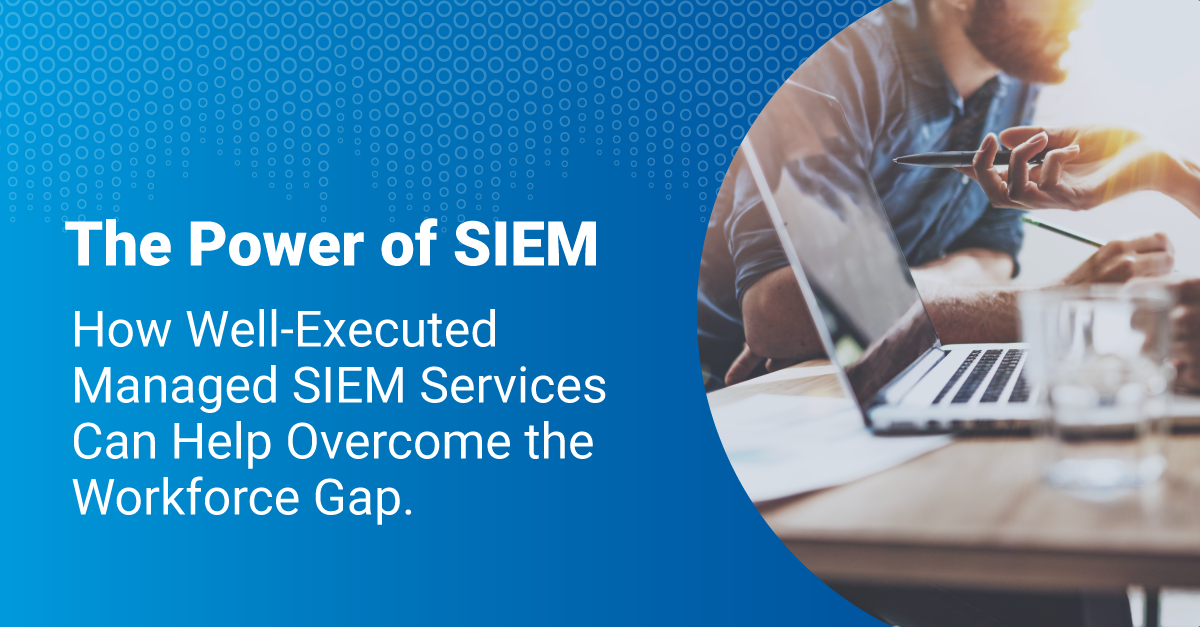Staffing Shortage Hampering Your SIEM Deployment? It Might Be Time for Managed SIEM.

By: Steven Rosenthal | Critical Start Director, Product Management
The skills shortage in cybersecurity is still a very real problem. Despite a recent influx of 700,000 professionals into the cybersecurity workforce, the (ISC)2® 2021 Cybersecurity Workforce Study shows that global demand for cybersecurity professionals continues to outpace supply — resulting in the Cybersecurity Workforce Gap. Perhaps nowhere is this gap more keenly felt than in companies trying to implement security information and event management (SIEM) technologies.
This blog will take a look at what makes SIEM so labor intensive and how well-executed Managed SIEM services can help overcome the workforce gap.
The power of SIEM
As the cornerstone technology of a security operation center (SOC), SIEM integrates with numerous IT systems and log sources to ingest data for event analysis in a “single pane of glass” or centralized platform. SIEM systems are useful tools for cybersecurity because they identify deviations from the norm in data compiled from multiple sources and then take appropriate action, such as logging additional information, generating an alert or instructing other security controls to take steps to stop an activity’s progress.
The payment card industry was an early adopter of SIEM in large enterprises due to SIEM’s ability to enforce PCI DSS compliance. In recent years, smaller organizations have begun to look at the benefits of SIEM in helping them spot patterns that are out of the ordinary.
By enabling enterprises to filter massive amounts of data and prioritize security alerts the software generates, SIEM enables organizations to detect incidents that may otherwise go undetected. It analyzes log entries to identify signs of malicious activity and can help recreate the timeline of an attack. SIEM can also help automate the generation of reports that include all the logged security events across sources to meet compliance requirements. This is just a partial list of SIEM benefits, but it is important to keep in mind that it has its limitations – primarily the length of time it takes to implement, along with the cost and expertise required to keep it up and running.
The need for Managed SIEM
Here are just some of the tasks that in-house teams must master in order to maximize the value of their SIEM solutions:
- Installing and configuring the SIEM tool, onboarding associated data sources and configuring the SIEM user interface
- Configuring the source device to log to the SIEM
- Configuring log parsers to provide universal query access to text-based data such as log files, XML files, CSV files, and key data sources
- Deciding which log sources to ingest. This is critical to prevent a “garbage in/garbage out” effect. Logging large volumes of data that does not have security value will alert fatigue and set your implementation up for failure.
- Applying the right detections to the selected log sources.
- Developing use cases and keeping them up to date
- Writing and tuning detection content
- Keeping the SIEM up to date (applying hot fixes, functional updates and version upgrades)
- Designing and building reporting content
- Monitoring threats
- Investigating security issues
- Addressing security mandates
Managed SIEM services can help with all of the tasks listed above—and more. The Gartner® Market Guide for Managed SIEM Services1 includes lists of key core capabilities and optional capabilities Managed SIEM providers should offer. We feel some vendors go above and beyond these proficiencies to offer additional value-added services. For example, we further augment our Managed SIEM customers’ staffs with a dedicated team of experts who help identify and continuously analyze log sources to ensure they are of high fidelity and deliver additional services such as Quarterly Service Reviews, Health Monitoring and Risk Reduction Reviews.
Give your team the gift of time
By turning over the heavy lifting involved in a SIEM implementation to an MDR vendor like Critical Start, you relieve your team from having to maintain your software or keep up to date with accreditations, allowing them to focus their efforts elsewhere and making your overall business more efficient. Managed SIEM also reduces your Total Cost of Ownership (TCO) by decreasing your in-house requirements and enhances your detection coverage and compliance posture. It can be a real game changer for you and your staff.
For more details about Critical Start Managed SIEM, visit our website at www.criticalstart.com.
1 – Gartner, Market Guide for Managed SIEM Services, Al Price, John Collins, Andrew Davies, Mitchell Schneider and Angela Berrios, August 17, 2022
Gartner does not endorse any vendor, product or service depicted in its research publications, and does not advise technology users to select only those vendors with the highest ratings or other designation. Gartner research publications consist of the opinions of Gartner’s research organization and should not be construed as statements of fact. Gartner disclaims all warranties, expressed or implied, with respect to this research, including any warranties of merchantability or fitness for a particular purpose.
GARTNER is a registered trademark and service mark of Gartner, Inc. and/or its affiliates in the U.S. and internationally and is used herein with permission. All rights reserved.

Director, Product Management | SIEM MDR
Steven Rosenthal, a cybersecurity expert, has spent his career assisting organizations in navigating technology threats. His experience includes a 12-year stint at IBM, managing complex data center projects, and leading IT program development at Dell EMC. As QTS Data Centers’ Head of Product Solutions, he guided product strategy and elevated the company’s market position. Steven is currently the Director of Product for Critical Start, where he shapes the company’s SIEM strategy and bolsters its cybersecurity posture. As a respected thought leader, Steven frequently shares his insights at industry events to help drive innovation and guide companies in building resilient and secure infrastructures.
You may also be interested in…
RESOURCE CATEGORIES
- Buyer's Guides(1)
- Consumer Education(39)
- Consumer Stories(2)
- Cybersecurity Consulting(4)
- Data Breaches(15)
- Data Privacy(43)
- Incident Response(2)
- Interview(51)
- MDR Services(59)
- MobileSOC(6)
- News(5)
- Press Release(101)
- Research Report(9)
- Security Assessments(2)
- Thought Leadership(19)
- Threat Hunting(3)
- Video(1)
- Vulnerability Disclosure(1)